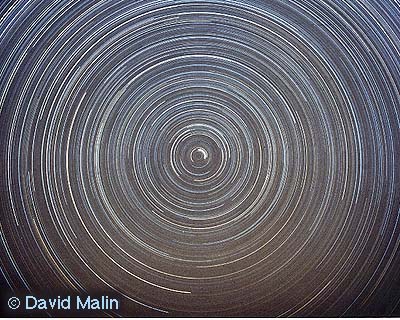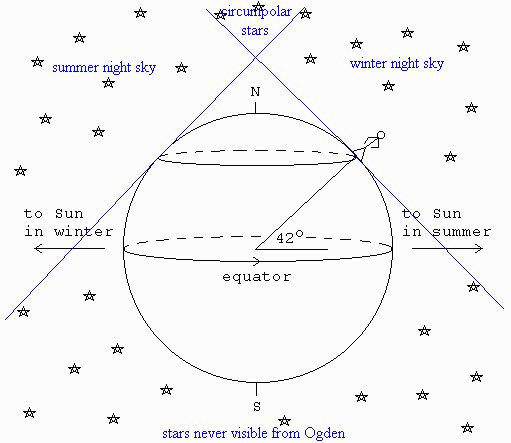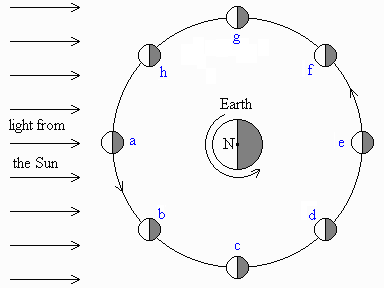PHYSICS 1040 - ELEMENTARY ASTRONOMY - HOMEWORK #1
1. List the following from largest to smallest: 3.0 x 10
8, 1.5 x 108,3.2 x 10
7, 2.0 x 1026, 4.0 x 10-10.(largest 2.0 x 1026, 3.0 x 108, 1.5 x 108, 3.2 x 107, 4.0 x 10-10 (smallest).
 2. In the star trails shown at right, the center of the
circular star pattern is the north celestial pole, and the
star that is closest to the pattern=
s center is Polaris.
2. In the star trails shown at right, the center of the
circular star pattern is the north celestial pole, and the
star that is closest to the pattern=
s center is Polaris.
3. Astrology is very old, and does not update itself as astronomy does. The Babylonians invented astrology over 2000 years ago; since then, the position of the Earth in its orbit at the time of the summer solstice (the first day of summer) has changed by about 1/12 of an orbit. This means that during any month, the Sun is now found in a constellation that is different/the same (circle one) than the constellation it was in 2000 years ago. Thus the Sun is almost never in the sign of the zodiac described by the Babylonians, but is one constellation off!
4. This drawing shows Earth in its orbit around the Sun.
Identify the times of the a) summer solstice; b) autumnal equinox; c) winter
solstice; and d) vernal equinox.
At the summer solstice the Sun is at its highest possible point in the sky, when it is 23 1/2 degrees north of the celestial equator. At the winter solstice the Sun is at its lowest possible point in the sky, when it is 23 1/2 degrees south of the celestial equator. And at the time of the autumnal and vernal equinoxes, the Sun is on the celestial equator.
5. In Ogden, the days with the most daylight occur in the month of June, while in Sydney, Australia, these days occur in the month of December.
6. Give two reasons why it is hot in Ogden during the summer.
a. The days are longer, so there is more time for heating by the Sun.
b. The Sun's rays hit the ground more nearly perpendicular, so their energy is more concentrated. ______________________________________________________________________________________________________________________________________
7. This drawing shows an Ogden astronomer on the rotating Earth, looking at the winter constellations in the winter night sky.
a) Draw her winter horizon line. Which stars can she see in the winter? Six months later she will be observing the summer constellations in the summer night sky.
b) Draw her summer horizon line. Which stars can she see in the winter night sky? c) Identify the circumpolar stars that are always visible from Ogden. d) Identify those stars that are never visible from Ogden.

8. On the figure at right of the Moon orbiting Earth, identify the following phases: a) new moon, b) waxing crescent, c) first quarter, d) waxing gibbous, e) full moon, f) waning gibbous, g) third quarter, and h) waning crescent. (Note that you are looking down on Earth= s north pole.)

By looking at the figure, determine at what time the
i. new moon will be overhead (on the meridian): noon
j. first quarter moon will be overhead: 6 pm
k. full moon will be overhead: midnight
l. third quarter moon will be overhead: 6 am
9. A lunar eclipse occurs when the Moon passes through Earth= s shadow. There are three types of lunar eclipse. A total lunar eclipse happens when the Moon is completely in the umbra of Earth= s shadow. A partial lunar eclipse occurs when only part of the Moon passes through the umbra of Earth= s shadow. A penumbral lunar eclipse happens when the Moon passes through Earth= s penumbra but not through its umbra. If a person living in Ogden sees a total lunar eclipse, then a person living in Phoenix (680 miles south) will / will not (circle one) see a total lunar eclipse.
10. A solar eclipse occurs when Earth passes through the Moon= s shadow. There are three types of solar eclipse. A total solar eclipse is seen where the observer is completely within the umbra of the Moon= s shadow, so the Sun= s disk is completely covered by the Moon. A partial solar eclipse is observed where the observer is completely within the penumbra of the Moon= s shadow, so only part of the Sun= s disk is covered by the Moon. An annular solar eclipse occurs when the Moon= s umbra doesn=t reach Earth; the Moon is too far from Earth for its disk to cover the disk of the Sun completely, so the outer edge of the Sun is seen as a ring. If a person living in Ogden sees a total solar eclipse, then a person living in Phoenix (680 miles south) will / will not (circle one) see a total solar eclipse.